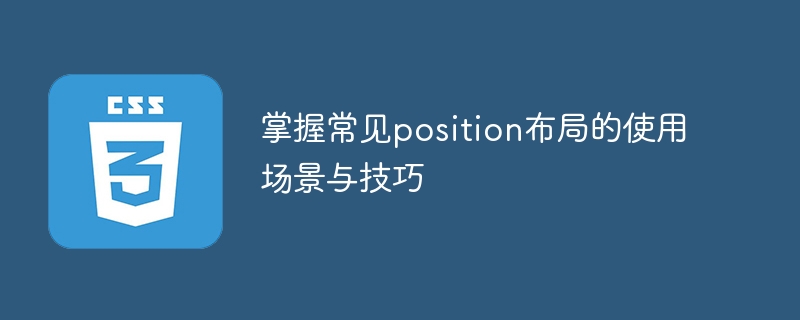

To master the usage scenarios and techniques of common position layout, specific code examples are required
Introduction:
In front-end development, layout is a crucial part . The position layout plays an important role in realizing the layout of web pages. It can help us achieve precise positioning of page elements and the realization of interactive effects. This article will introduce common usage scenarios and techniques of position layout, and provide specific code examples to help readers better master the techniques of position layout.
1. What is position layout
Position layout is a positioning method in CSS, which allows us to more accurately control the position of HTML elements on the page. Common position values include static, relative, absolute and fixed. Below we will introduce in detail the usage scenarios and techniques of these position values.
<div style="position: static;"> 这是一个静态定位的元素 </div>
<div style="position: relative; top: 20px; left: 10px;"> 这是一个相对定位的元素 </div>
<div style="position: relative;">
<div style="position: absolute; top: 20px; left: 10px;">
这是一个绝对定位的元素
</div>
</div><div style="position: fixed; top: 20px; left: 10px;"> 这是一个固定定位的元素 </div>
2. Usage scenarios and techniques of position layout
After understanding the basic knowledge of position layout, below we will introduce some common usage scenarios and techniques of position layout.
<div style="position: relative;"> <button style="position: absolute; top: 0; right: 0;">按钮</button> </div>
<div style="position: relative; width: 200px; height: 200px;"> <div style="position: absolute; top: 50px; left: 50px; width: 100px; height: 100px; background-color: red; z-index: 10;"></div> <div style="position: absolute; top: 100px; left: 100px; width: 100px; height: 100px; background-color: blue; z-index: 1;"></div> </div>
<nav style="position: fixed; top: 0; left: 0; width: 100%; background-color: #f1f1f1;"> 导航栏 </nav>
Summary:
This article introduces the usage scenarios and techniques of position layout in front-end development, and provides specific code examples. By mastering the usage skills of position layout, we can better master the positioning of page elements and the realization of interactive effects. I hope this article will be helpful to readers in their layout work in front-end development.
The above is the detailed content of Analysis of application scenarios and techniques of common position layouts. For more information, please follow other related articles on the PHP Chinese website!
 Mechanical energy conservation law formula
Mechanical energy conservation law formula
 How to solve the problem that the phpstudy port is occupied
How to solve the problem that the phpstudy port is occupied
 How to check port status with netstat
How to check port status with netstat
 Top 30 global digital currencies
Top 30 global digital currencies
 Compressed file encryption
Compressed file encryption
 What software is ae
What software is ae
 kb4012212 What to do if the update fails
kb4012212 What to do if the update fails
 How many types of usb interfaces are there?
How many types of usb interfaces are there?




